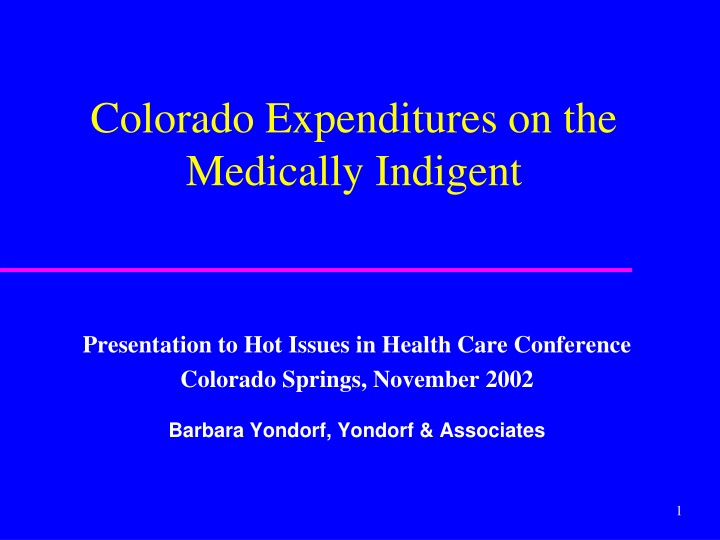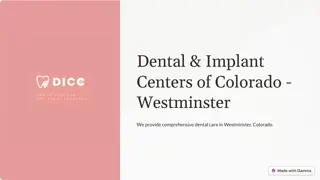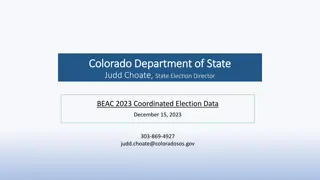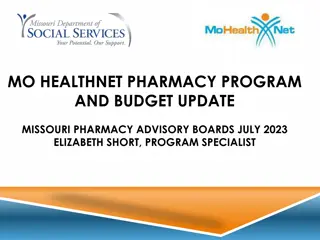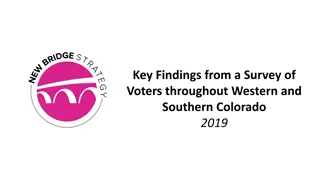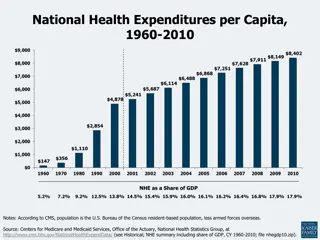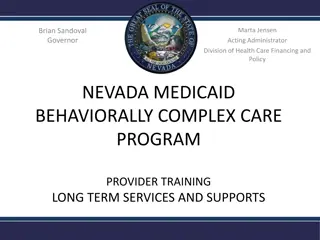Colorado Expenditures on the Medically Indigent Presentation
The presentation focuses on Colorado's expenditures for the medically indigent, conducted by Yondorf & Associates. It outlines the background of the expenditures project, preliminary findings, and possible policy implications. The project aims to estimate current spending on Coloradans who cannot afford insurance coverage, with the goal of achieving health insurance coverage for all residents by 2007. Various programs and funds examined include Medicaid, community health clinics, mental health centers, and more. Preliminary findings suggest billions of dollars are spent annually by low-income families and organizations on care/coverage for the medically indigent.
Download Presentation

Please find below an Image/Link to download the presentation.
The content on the website is provided AS IS for your information and personal use only. It may not be sold, licensed, or shared on other websites without obtaining consent from the author.If you encounter any issues during the download, it is possible that the publisher has removed the file from their server.
You are allowed to download the files provided on this website for personal or commercial use, subject to the condition that they are used lawfully. All files are the property of their respective owners.
The content on the website is provided AS IS for your information and personal use only. It may not be sold, licensed, or shared on other websites without obtaining consent from the author.
E N D
Presentation Transcript
<<!-- PICOTITLE= " Colorado Expenditures on the Medically Indigent" --> <!-- PICODATESET mmddyyyy=11012002 --> Colorado Expenditures on the Medically Indigent Presentation to Hot Issues in Health Care Conference Colorado Springs, November 2002 Barbara Yondorf, Yondorf & Associates 1
Presentation Outline Background on expenditures project Some preliminary findings Initial observations Possible policy implications Yondorf & Associates 2
Background on Expenditures Project Project of Colorado Coalition for the Medically Underserved (CCMU)* Y & A hired to develop estimate of current spending on Coloradans who cannot afford insurance coverage CCMU interested in: Amount currently being spent by whom, for whom, for what Additional funds needed to insure all Can existing dollars be better spent Project still in progress; final paper Feb/Mar 2003 * CCMU is a broad-based coalition dedicated to achieving health insurance coverage for all Coloradans by 2007, using a variety of public and private mechanisms. Major funding for the expenditures project is provided by The Colorado Trust. 3
Focus of Project Low-income (< 200% FPL*) persons who cannot afford private coverage (e.g., primarily working poor families) Medical care only (excludes health education, translation services, abstinence programs, etc.) Major programs, targeted at persons who cannot afford coverage on their own (excludes general public health programs, VA, Medicare, etc.), where data exist Mainly uninsured low-income families, but also some data on Medicaid and CHP+. 4 * 200 % FPL= $17,720 per year for a single person and $36,200 for a family of four.
Programs & Funds Examined Medicaid Other community health clinics CHP+ Mental health cmty centers CICP/DSH Children s dental Primary grants pgm Kaiser Connections Health dept. prgms Hospital cost-shifting State mental health Local hosp. tax subsidies Substance abuse Foundation grants Local health depts Out-of-pocket payments Cmty health centers Physician & other donated care 5 Yondorf & Associates
Some Preliminary Findings Several billion dollars spent each year in state, federal, local & private funds, and out-of-pocket payments by low-income families themselves on care/coverage for the medically indigent. This includes funds for Medicaid, CHP+ and programs for the uninsured (perhaps $2.5-$3.5 billion?) Hundreds of millions is spent each year on care for uninsured, low-income families (including payments made by the uninsured themselves), excluding public insurance programs and donated care (perhaps $400-$700 million?) continued 6 Yondorf & Associates
Some Preliminary Findings (p. 2) Major sources of funding for care programs for the uninsured medically indigent include: Federal government Medically indigent themselves Privately insured and self-pay patients in the form of hospital cost-shifting State government 7 Yondorf & Associates
Some Preliminary Findings (p. 3) Huge array of mainly uncoordinated sources fund indigent care. Some examples: Mat. & child health funds Substance abuse funds Earmarked local taxes Substance abuse grants DSH funds Multiple foundation funds Mental health block grant Local school districts Funds for specific chronic diseases and cancers Hospital cost shifting to private payers Public health section 330 funds Local government expenditures Vaccines for children program Immunization Fund Major teaching hospital funds Kaiser Cmty Benefit Fund Ryan White Act funds Title X family planning funds 8
Initial Observations A lot is being spent in Colorado on low-income persons who are uninsured. However Total expenditures fall short of what would be needed to cover all of the uninsured or to provide them with all of the medically necessary care they need (even assuming reasonable patient cost-sharing requirements). Despite level of spending, there are still serious gaps in the safety net of care for the low-income uninsured: Not everyone has same access Non-emergency & non-primary care, & adult dental care funding are minimal continued 9
Initial Observations (contd) System inefficiencies appear to be significant: Working poor families and others have to track down & qualify for all sorts of different, often uncoordinated programs to meet their needs In many cases, funders are not coordinating their expenditures High administrative costs associated with trickle down system of doling out funds State doing pretty good job of leveraging general funds but there are more dollars that could be federally matched. Level of public sector funding for those who cannot afford coverage on their own directly affects private sector costs. 10
Possible Policy Implications Take steps to fill holes in the safety net. Possible ways to fund this might include: Reducing administrative inefficiencies Streamlining eligibility determination for different programs Better leveraging existing dollars Tracking actual people through the system to improve efficient utilization and do disease management Explore local demonstration projects that allow for combining various funding pots Work with business community & consumer groups to find solutions continued 11
Possible Policy Implications (p. 2) Be aware in making budget cuts that almost every $1 in general fund spending to help pay for those who cannot afford the full cost of their own medically necessary care results in an additional $1 - $2 reduction in matching federal funds. (This might be called a negative multiplier effect. ) 12
